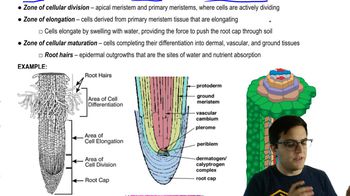Table of contents
- 1. Introduction to Biology2h 42m
- 2. Chemistry3h 40m
- 3. Water1h 26m
- 4. Biomolecules2h 23m
- 5. Cell Components2h 26m
- 6. The Membrane2h 31m
- 7. Energy and Metabolism2h 0m
- 8. Respiration2h 40m
- 9. Photosynthesis2h 49m
- 10. Cell Signaling59m
- 11. Cell Division2h 47m
- 12. Meiosis2h 0m
- 13. Mendelian Genetics4h 44m
- Introduction to Mendel's Experiments7m
- Genotype vs. Phenotype17m
- Punnett Squares13m
- Mendel's Experiments26m
- Mendel's Laws18m
- Monohybrid Crosses19m
- Test Crosses14m
- Dihybrid Crosses20m
- Punnett Square Probability26m
- Incomplete Dominance vs. Codominance20m
- Epistasis7m
- Non-Mendelian Genetics12m
- Pedigrees6m
- Autosomal Inheritance21m
- Sex-Linked Inheritance43m
- X-Inactivation9m
- 14. DNA Synthesis2h 27m
- 15. Gene Expression3h 20m
- 16. Regulation of Expression3h 31m
- Introduction to Regulation of Gene Expression13m
- Prokaryotic Gene Regulation via Operons27m
- The Lac Operon21m
- Glucose's Impact on Lac Operon25m
- The Trp Operon20m
- Review of the Lac Operon & Trp Operon11m
- Introduction to Eukaryotic Gene Regulation9m
- Eukaryotic Chromatin Modifications16m
- Eukaryotic Transcriptional Control22m
- Eukaryotic Post-Transcriptional Regulation28m
- Eukaryotic Post-Translational Regulation13m
- 17. Viruses37m
- 18. Biotechnology2h 58m
- 19. Genomics17m
- 20. Development1h 5m
- 21. Evolution3h 1m
- 22. Evolution of Populations3h 52m
- 23. Speciation1h 37m
- 24. History of Life on Earth2h 6m
- 25. Phylogeny2h 31m
- 26. Prokaryotes4h 59m
- 27. Protists1h 12m
- 28. Plants1h 22m
- 29. Fungi36m
- 30. Overview of Animals34m
- 31. Invertebrates1h 2m
- 32. Vertebrates50m
- 33. Plant Anatomy1h 3m
- 34. Vascular Plant Transport1h 2m
- 35. Soil37m
- 36. Plant Reproduction47m
- 37. Plant Sensation and Response1h 9m
- 38. Animal Form and Function1h 19m
- 39. Digestive System1h 10m
- 40. Circulatory System1h 57m
- 41. Immune System1h 12m
- 42. Osmoregulation and Excretion50m
- 43. Endocrine System1h 4m
- 44. Animal Reproduction1h 2m
- 45. Nervous System1h 55m
- 46. Sensory Systems46m
- 47. Muscle Systems23m
- 48. Ecology3h 11m
- Introduction to Ecology20m
- Biogeography14m
- Earth's Climate Patterns50m
- Introduction to Terrestrial Biomes10m
- Terrestrial Biomes: Near Equator13m
- Terrestrial Biomes: Temperate Regions10m
- Terrestrial Biomes: Northern Regions15m
- Introduction to Aquatic Biomes27m
- Freshwater Aquatic Biomes14m
- Marine Aquatic Biomes13m
- 49. Animal Behavior28m
- 50. Population Ecology3h 41m
- Introduction to Population Ecology28m
- Population Sampling Methods23m
- Life History12m
- Population Demography17m
- Factors Limiting Population Growth14m
- Introduction to Population Growth Models22m
- Linear Population Growth6m
- Exponential Population Growth29m
- Logistic Population Growth32m
- r/K Selection10m
- The Human Population22m
- 51. Community Ecology2h 46m
- Introduction to Community Ecology2m
- Introduction to Community Interactions9m
- Community Interactions: Competition (-/-)38m
- Community Interactions: Exploitation (+/-)23m
- Community Interactions: Mutualism (+/+) & Commensalism (+/0)9m
- Community Structure35m
- Community Dynamics26m
- Geographic Impact on Communities21m
- 52. Ecosystems2h 36m
- 53. Conservation Biology24m
33. Plant Anatomy
Growth
Problem 3`
Textbook Question
Which statement best characterizes primary growth?
a. It does not occur in roots, only in shoots.
b. It leads to the development of cork tissue.
c. It produces the dermal, ground, and vascular tissues.
d. It produces rings of xylem, phloem, and cork tissue.
 Verified step by step guidance
Verified step by step guidance1
Understand the concept of primary growth: Primary growth in plants refers to the elongation of roots and shoots, allowing the plant to grow in length. This growth is facilitated by the activity of apical meristems, which are regions of actively dividing cells located at the tips of roots and shoots.
Recall the types of tissues produced during primary growth: The apical meristems give rise to three primary meristematic tissues—protoderm, ground meristem, and procambium. These tissues differentiate into the dermal, ground, and vascular tissues, respectively.
Eliminate incorrect options: a) Primary growth occurs in both roots and shoots, so this option is incorrect. b) Cork tissue is associated with secondary growth, not primary growth, so this option is also incorrect. d) Rings of xylem, phloem, and cork tissue are produced during secondary growth, not primary growth, so this option is incorrect.
Focus on the correct option: c) Primary growth produces the dermal, ground, and vascular tissues, which are essential for the plant's structure and function during elongation.
Conclude by connecting the concept to the correct answer: The correct statement is that primary growth produces the dermal, ground, and vascular tissues, as these are the fundamental tissues formed during the elongation process driven by apical meristems.
 Verified video answer for a similar problem:
Verified video answer for a similar problem:This video solution was recommended by our tutors as helpful for the problem above
Video duration:
1mPlay a video:
Was this helpful?
Key Concepts
Here are the essential concepts you must grasp in order to answer the question correctly.
Primary Growth
Primary growth refers to the increase in length of the plant, occurring at the apical meristems located at the tips of roots and shoots. This type of growth is responsible for the elongation of the plant and the formation of new leaves and flowers, allowing the plant to reach sunlight and expand its root system.
Recommended video:
Guided course

Primary Meristems
Tissue Types in Plants
Plants consist of three main tissue types: dermal, ground, and vascular tissues. Dermal tissue serves as a protective outer layer, ground tissue is involved in photosynthesis, storage, and support, while vascular tissue (xylem and phloem) is responsible for the transport of water, nutrients, and food throughout the plant.
Recommended video:
Guided course

Vascular Tissue
Meristematic Tissue
Meristematic tissue is a type of plant tissue that contains undifferentiated cells capable of division and growth. This tissue is crucial for both primary and secondary growth, as it allows for the continuous production of new cells that differentiate into various specialized tissues, contributing to the overall development of the plant.
Recommended video:
Guided course

Vascular Tissue
Related Videos
Related Practice





















